Lucayan legacy





Here’s a collection curated by The Associated Press’ entertainment journalists of what’s arriving on TV,
streaming services and music plat forms this week.
MOVIES • Is it really time to say goodbye to Jamie Lee Curtis’ Laurie Strode? That’s the idea behind “Hal loween Ends,” which promises some kind of conclusion to the Michael Myers saga, which has been going on now for 45 years, and as the promos tease “only one of them will sur vive.” Director David Gordon Green returns to close his modern trilogy, which will be released in theaters and on Peacock on Friday. The last film, “Halloween Kills,” ended on a cliffhanger with a mob rising up to hunt down Michael Myers. Green said in an interview recently that, “Any frustration that was expressed about the last one, I kind of just smile and say, ‘Hold tight, here we come.’”
• On video on demand, you can check out “Piggy,” a horror that got good buzz out of the Sundance Film Festival early this year. The film stars
she spends her summers. But things take a turn when she finds that her tormenters have been kidnapped and she has to figure out what to do about it. It’s the feature debut of Carlota Pereda, who wrote the script, and whose work on the film drew comparisons to Brian De Palma and “Carrie.”
MUSIC • Red Hot Chili Peppers aren’t ready to stop spicing up our lives this year. Their album “Return of the Dream Canteen,” comes out Friday, their second album release of 2022, following “Unlimited Love” from April. Once again, they’ve joined forces with longtime producer and creative confidant Rick Rubin, with an early single being “Tippa My Tongue.” In between albums, the band won the prestigious Global Icon Award and performed at the MTV Video Music Awards. The
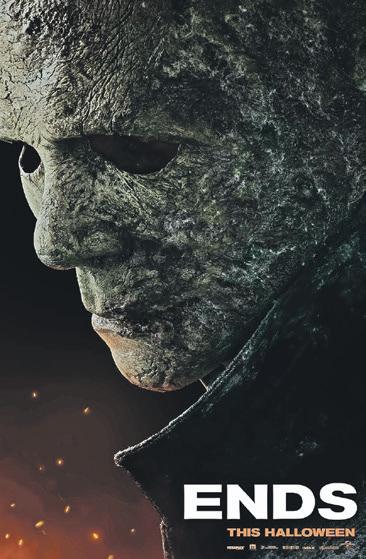 By The Associated Press
By The Associated Press
band says the new album ”is every thing we are and ever dreamed of being. It’s packed. Made with the
blood of our hearts.”
• Global trailblazer and provoca teur M.I.A. is back and you better make room. “Beep, beep! Yeah, I’m tryna come through,” she sings on the hypnotic “Beep” from the new album, “Meta.” Other singles include “The One” and “Popular,” where M.I.A.’s sarcastic view of fame is hard to hide: “Suddenly it’s about me, ’bout me/ Now you wanna be around me, ’round me.” The followup to 2016’s “Aim,” “Mata” is years in the making, its compositions recorded in London, Los Angeles, Italy, Bali, Jakarta and St Vincent.
(Meg Donnelly) in the 1970s. He’s a newly returned Vietnam War veteran, she’s fighting her own battles as a demon hunter, and they are intent on uncovering secrets kept by both their families. The series debuted on Tuesday on the CW.


TELEVISION • “Supernatural,” which ended its 15-year-run in 2020, begat a comic book series, novels and, finally, a spin-off about brothers Sam and Dean Winchester’s parents. Dean (Jensen Ackles) serves as narrator
• “Shantaram” is another bookbased series, this time the novel of the same name by Gregory David Roberts. In vividly depicted 1980s Bombay, India, fugitive Lin Ford (Charlie Hunnam) is trying to disap pear into a new life but finds that old patterns and love are getting in the way. It’s a grueling journey for Lin, as it was in the novel that Roberts has said incorporates elements of his own life, including drugs, prison and an unlikely role as healer. The Apple TV+ series debuts today with three episodes, with the remaining nine episodes released weekly.

AN Abaco-based pastry chef who has been featured in Pastry Arts Magazine and competed with the best in the World’s Greatest Baker challenge has now attracted celebrity attention.
Chanté Basden, a third-generation chef, recently made birthday cakes for celebrity chef Jacques Torres and rapper Pitbull.
The pastry chef runs her family’s bakery in Abaco.
She holds a Bachelor of Arts degree in International Baking and Pastry Culinary Arts and in Business Administration.
One of her major goals has been to introduce Bahamian pastries and desserts to people all around the world, and she is well on her way to achieving that goal.
“As of recent my cakes have been hitting the tables of celebrities. This has been such an honour,” she said.
She first made a nautical themed cake for the son of Chef Jacques Torres, a French pastry chef and chocolatier who is best known to the general public for his appearance as a judge on season four of the Next Great Baker. He is also a judge on the Netflix comedy cooking show Nailed It! alongside Nicole Byer.

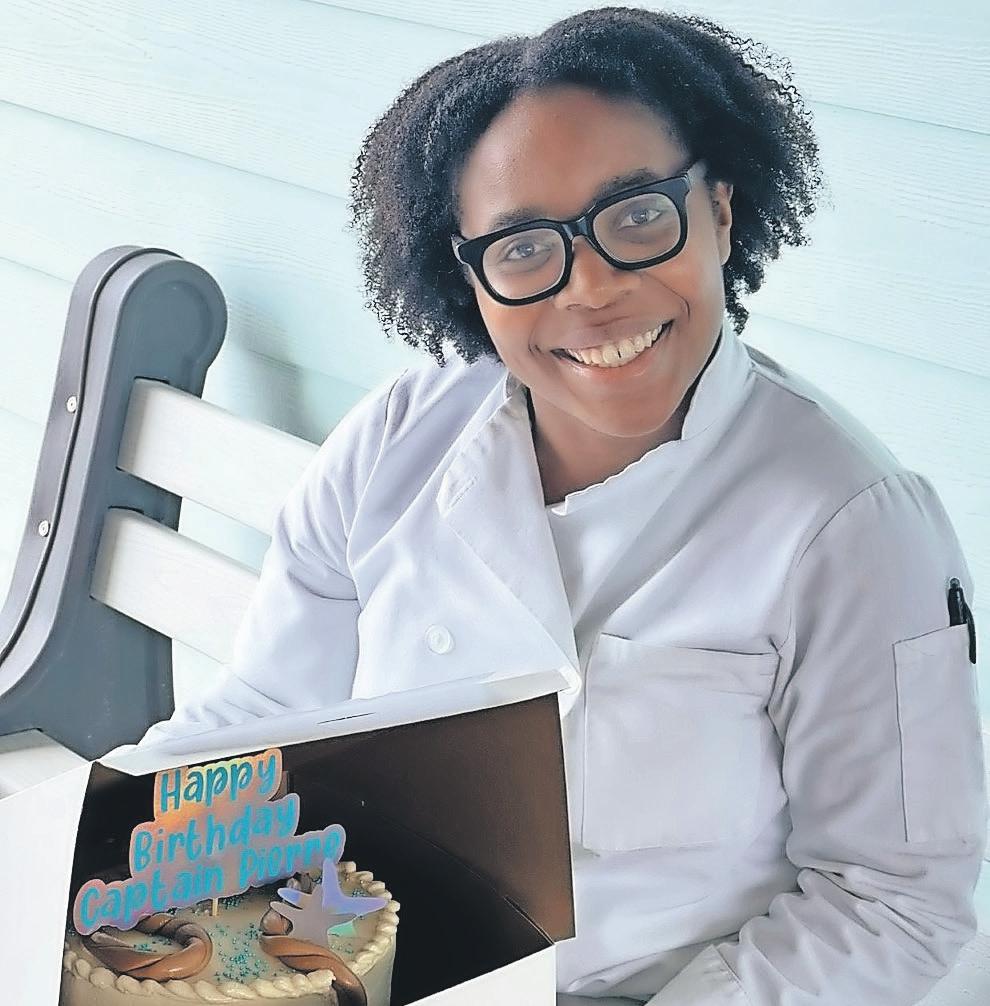
She also made one of her sig nature chocolate cakes for the wife of American rapper and busi nessman Pitbull. He has sold over 25 million albums and over 100 million singles worldwide.
Chanté says her cakes have a secret ingredient: love.
“I choose to bake and deco rate each cake as if it were made for myself and filled with love,” she told Tribune Weekend.

Chanté said she is now looking for ward to returning to the competition arena to showcase her baking skills.
“I will also start my classes to show future kitchen enthusiasts how to get their career started,” she added.
Her advice to budding chefs is to relax and enjoy the process.
“A lot of times we try to compli cate things and you can actually take the fun out of baking, so just enjoy it.”
Earlier this year, Chanté raised concerns about rising food prices in the Bahamas. She is passionate about helping to feed the people of Abaco, but it’s not an easy undertak ing with recent price hikes on basic items like milk and bread.
To that end, she decided to partner with the Rotary Club of Abaco and the No Kid Hungry organisation, as
well as with the American based-charity run by Share Our Strength, a nonprofit working to solve problems of hunger and poverty around the world.
She also recently ticked off another item on her bucket list by opening her own culi nary supply store called Chef Factory.
first-of-its-kind exhibition is aiming to show the indigenous inhabitants of the Bahamas within the context of their own history, before the European conquest of the Americas.

“Lucayans: The Valor of the Vanquished”, presented by the Antiquities, Monuments and Museum Corporation (AMMC), opened this week at the National Museum of the Bahamas.
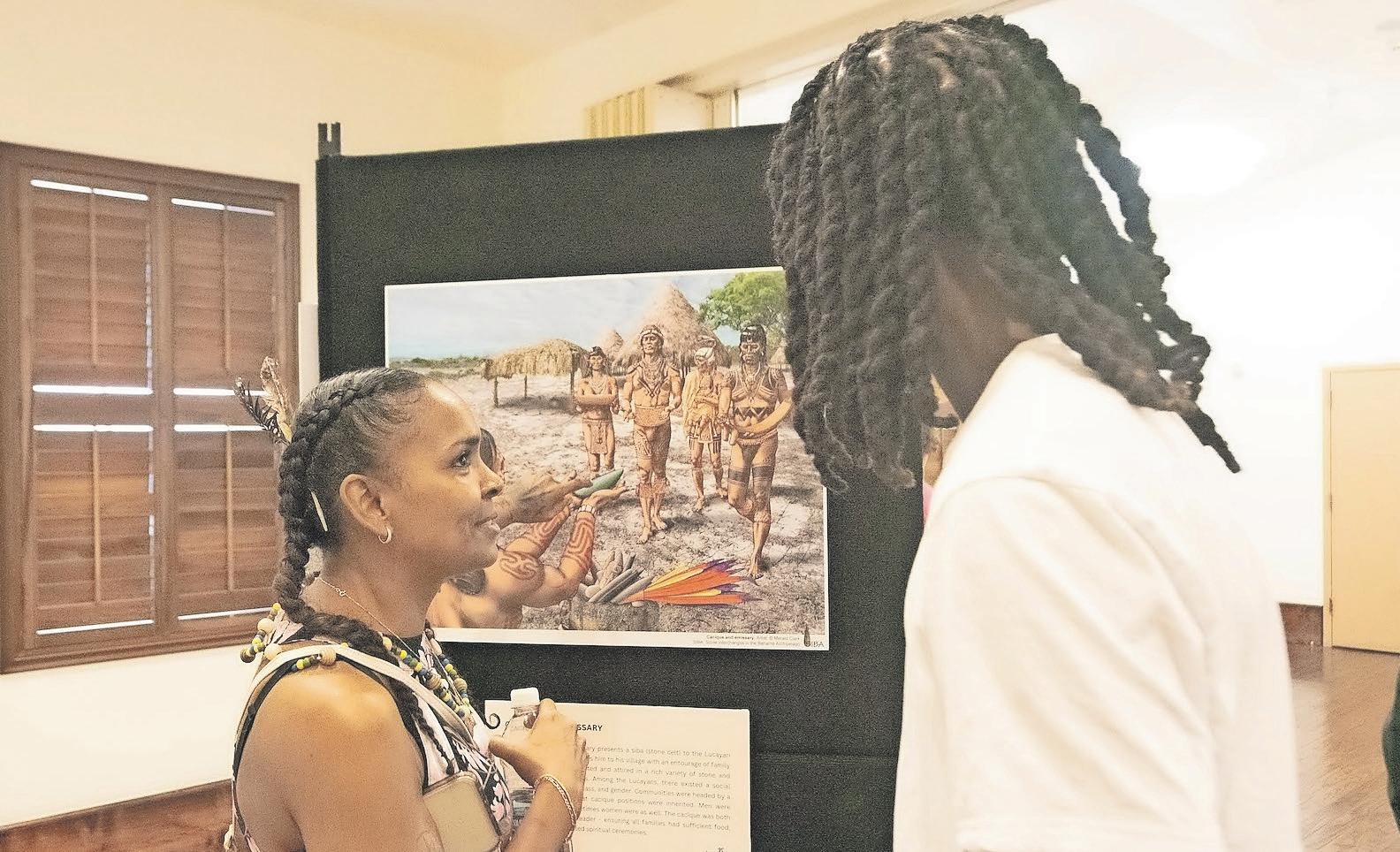
The exhibition also serves the purpose of highlighting the archaeo logical heritage of the islands.
The Lucayans were a branch of the Taino people, who inhabited most of the Caribbean islands at the time. They were the first indigenous people encountered by Christopher Columbus when he arrived in the Americas in 1492.
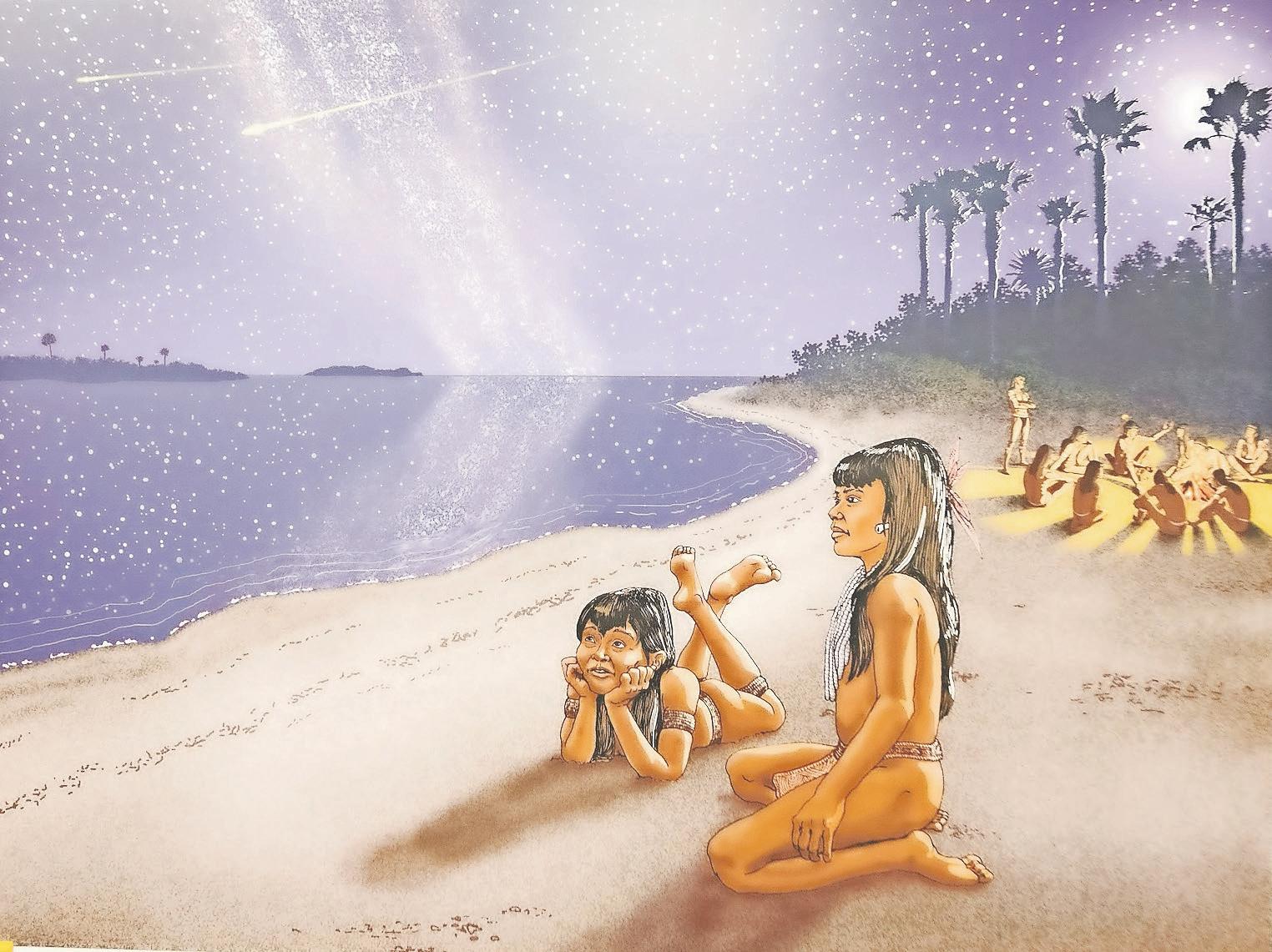
Historians believe the Lucayans lived in the Bahamas from about 700 AD. At peak numbers, the population is estimated to have been around 40,000.
However, shortly after contact, the Spanish kidnapped and enslaved the Lucayan people. The population was completely decimated by 1520 due to disease and the repercussions of slavery.
They left very few physical clues behind, and Mayaguana is the only island in the chain of Bahamian islands that still bears its original Lucayan name.
AMMC was happy to open the exhibition with a special ceremony on Wednesday that was attended by
Prime Minister Philip Davis and other government officials.
The Corpo ration said it is very excited and enthusiastic about the general public viewing this showcase. It will be displayed until March 4, 2023.
The exhibition features life-size mannequins, a miniature Lucayan vil lage, hands-on experiences with artefacts, and an immersive sound room.
One of the most exciting features of this exhibition is the display of an actual duho, which is the ceremonial stool of the Cacique (chief).
There are over 30 artefacts on dis play and three life-size mannequins.
“The aim is to show the Lucayans within the context of their own histories — not as a backdrop to European history — and to highlight the rich archaeo logical heritage of the region,” said Nameiko Miller, curator of museum.
artworks, which are inspired by the many unique artefacts that have been recovered over the last century, reflect the latest understandings of the archaeology of the archipelago. They focus on various subjects, from the skills needed to carve a canoe or weave a hammock, to food produc tion, to the social dynamics and trade networks that linked the Lucayans to their southern neighbours in Cuba and Hispaniola. These images are intended as windows onto a Lucayan past, to spur imagination and engagement in classrooms,” she told Tribune Weekend.
In addition to the artwork, the exhibit highlights pre-Columbian artefacts from the museum’s collec tions. These include Lucayan skulls, shells, beads, cemis, duhos, stone and ceramic finds.

“Viewers will be exposed to the lived experiences of the Lucayans. In the Lucayan archipelago, history does not start in 1492 with Colum bus simply because this is the first time a European wrote about these islands; histories exist without being written. Long before the arrival of Europeans, the people who made the islands their home had their own sagas —recounted and inherited by each subsequent generation,” Ms Miller said.
An education table, where museum objects will be displayed, will allow visitors to “touch a piece
• In 1892, The Adventures of Sherlock Holmes by Arthur Conan Doyle is published. The book was the first collection of stories featuring the famous fictional detective, who is believed to be based on Dr Joseph Bell, a teacher with extraordinary deductive power at the University of Edinburgh. Prior to the book’s publication, the Holmes stories had been published in magazines starting in 1887.
• In 1947, American test pilot, and former combat fighter
of history”.
“Pre-Columbian artefacts have been collected for well over a cen tury in the Bahamas. Providing the public with a glimpse of this collec tion is something we are proud of. AMMC’s museum collections reflect
during World War II, Chuck Yeager becomes the first person to break the sound barrier. His rocket plane, the X-1 (nicknamed “Glamorous Glennis” after his wife), was lifted to an altitude of 25,000 feet by a B-29 aircraft and then released through the bomb bay, rocketing to 40,000 feet and exceeding 662 miles per hour (the sound barrier at that altitude).
• In 1839, encouraged by her uncle Leopold, Queen Victoria of England proposes to her cousin, Prince Albert, during his second visit to Windsor Castle in Berkshire. They said they had fallen in love almost immediately when they first met in 1836. The royal couple were married for 21 years, until his death on December 14, 1861. After his death, the Queen wore black in mourning
our mandate, which is to collect, pre serve, research, exhibit, and interpret objects that best serve to illustrate the history of the Bahamas,” she said.
The AMMC mission is to protect, preserve, and promote the historic
cultural resources of the Bahamas. The organisation does this while protecting the environment, encour aging research and archaeology, and by promoting our historic sites.
MARIE-Antoinette, who was executed on October 16, 1793.
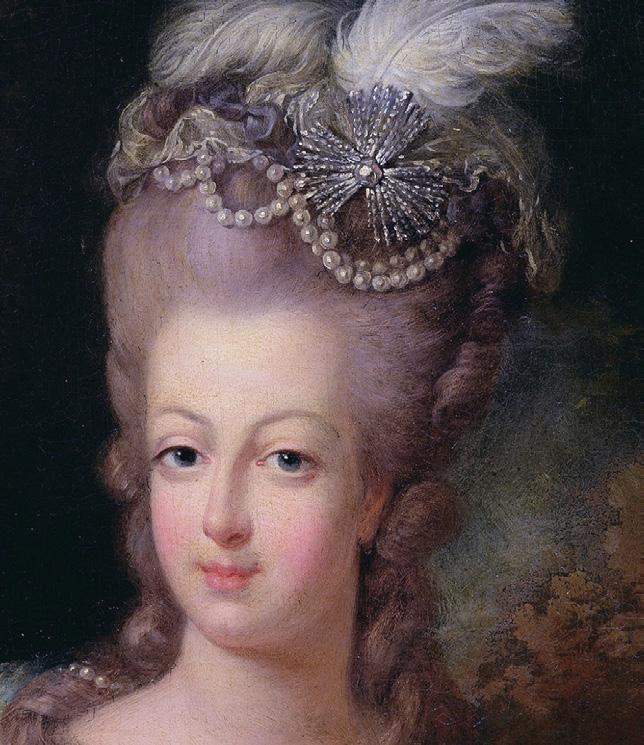
for the rest of her life.
• In 1990, Soviet leader Mikhail Gorbachev wins the Nobel Peace Prize “for the leading role he played in the radical changes in East-West relations”. Since coming to power in 1985, Gorbachev had gone to extraordinary lengths to reach
foreign policy understandings with the noncommunist world, therefore ending Cold War tensions.
• In 1793, Marie-Antoinette, queen consort of King Louis XVI of France, is executed by guillotine. She was 37 years old. This comes nine months after her husband was beheaded in 1792, the French monarchy was abolished, and Louis and Marie-Antoinette were condemned for treason by the Revolutionary Tribunal.
• In 1978, Karol Józef Wojtyła of Poland is elected pope, assuming the name John Paul II. He was the first non-Italian pontiff since Adrian VI some 455 years earlier. He becomes the second-longest-serving pope after Pius IX in modern history, serving for 26 years until his death in 2005.
Art: Merald Clark Photos: Moise Amisial By ALESHA CADET | Tribune Features Writer | acadet@tribunemedia.net
By ALESHA CADET | Tribune Features Writer | acadet@tribunemedia.net
that borders
being from an island nation
the peak of the COVID-19 pandemic
inspired kremas and epis which are now being sold in Walmart stores and on Amazon.
decided to launch
Epis is a traditional Haitian seasoning base. Known as sofrito in the Hispanic cuisine and green seasoning in Caribbean cuisine, epis is an organic vegetable blend of seasonings used in the Haitian kitchen to marinate meat, seafood, make stew, soup, and also rice and beans.
Julie said she makes her epis with out preservatives, gluten or dairy.
Kremas (or Cremasse) is a popular drink in Haiti that is served at social events and during the holidays.
Julie explained that the drink is similar to Bailey’s or the Puerto Rican Coquito; it is a coconut-based drink with a fusion of aromatic spices such as cinnamon and nutmeg to give it its smooth taste.

“Our goal at 1804 Kremas and Epis is to help people experi ence the joy and depth that is the Haitian culture, through food and drink, of course,” Julie told Tribune Weekend.
The company remains familyowned and the products are made by the Josue family in the Bahamas and in Orlando, Florida.
“The entire process of making kremas and epis is done primarily by hand,” she said.
“Before I left (the Bahamas), my mom and I introduced the kremas to the Bahamian consumers so they
knew what kremas was all about. Gradually, we are introducing the epis to the Bahamian consumers and we are showing what the epis can be used for. The same way when we introduced pikliz (pickled vegetable relish) to the Bahamas.”

Julie loves it when she can incor porate both her cultural backgrounds into her cooking. For example, she fries down her Bahamian peas n’ rice with her 1804 Haitian epis.
She also switches it up for differ ent seasons; for fall, for example, she is selling kremas in the flavour of pumpkin spice and a peppermint flavour will be introduced for the Christmas holidays.
Julie also hopes to host a big sale and a pop-up event in the Bahamas for the Yuletide season.
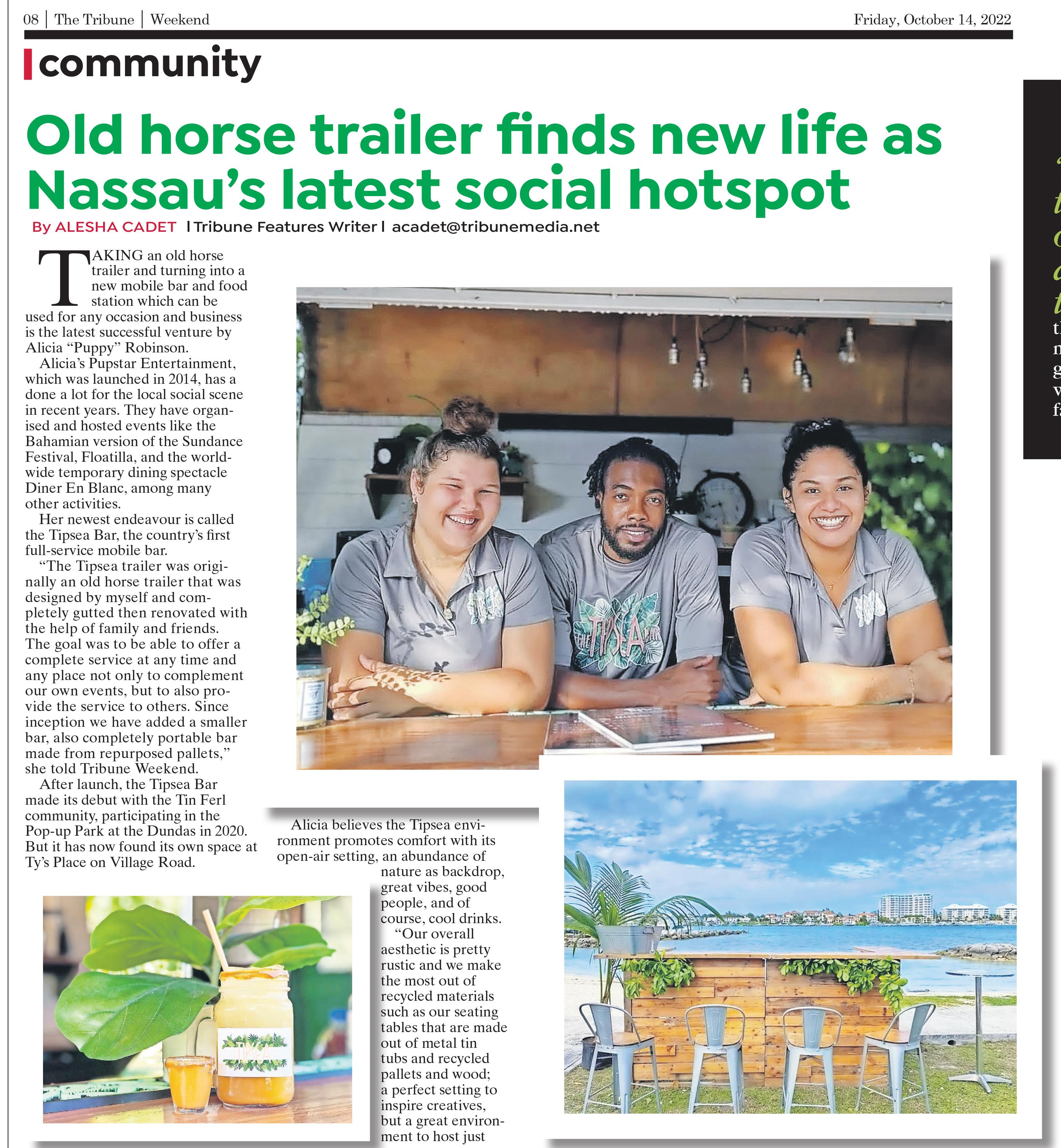

day, gardeners. There are a few plants that are relatively inde structible indoors and outdoors, even for the beginning gardener.
Today’s focus is on the snake plant, formerly known as Sansevieria trifasciata but reclas sified as Dracaena trifasciata in 2017. Why was this plant reclas sified as Dracaena? It appears nothing like a Dracaena, and I found it quite strange. It turns out that the plant was renamed on the basis of molecular phylogenetic studies. What is a molecular phy logenetic study? It is the branch of phylogeny that analyses genetic, hereditary molecular differences, predominantly in DNA sequences, to gain information on an organism’s evolutionary relationship. Molecular phylogenetics makes inferences of the evolutionary relationships that arise due to molecular evolution and results in the construction of a phylo genetic tree. What? Who knew that it was quite so involved?! It’s just a plant, right? Most people will forever refer to this plant as Sansevieria.

Moving on, the Dracaena tri fasciata belongs to the family Asparagaceae, native to the trop ics of West Africa. A lot of people believe the name comes from “sand snake”, with its cacti like properties and appearance of a rising snake it’s not hard to see why. However, the plant genus Sansevieria was actually named in 1794 by the Swedish natu ralist Carl Thunberg after Raimondo di Sangro (1710-1771), Prince of San Seviero.
According to the website Our House Plants, its bold and clutterfree lines make it very popular and one of the plants of choice for architecture and interior design, especially because of its reputation as an improver of indoor air quality.
Studies have shown that while it is effective at removing airborne pollutant. In reality it is on such a minimum scale that it’s a bit of a gim mick to market the plant as such. It is a very strong and tolerant plant to
have indoors, it toler ates irregular waterings and practically any light situation.
The easiest way and one of the only ways to kill this plant is by giving it too much water. They can go weeks or indoors sometimes months without water ing. Overwatering is the most common reason for not being successful with indoor plants.
I say all of that to say this is an excellent plant for beginners or for those that claim to have a “black thumb” as people refer to those that tend to not seem to keep plants alive very well inside the home or office. Outdoors it is also extremely versatile. It is relatively salt tolerant, very wind tolerant, and as mentioned, it is extremely drought tolerant, and it is highly tolerant under full sun or full shade. When planted in the landscape, this plant requires zero attention. Some of the most popular and available cultivars are D. trifasciata, which is all green in colour, and the D. trifasciata ‘Lau rentii’ that has lovely variegation on the leaf edges, D. trifasciata ‘Black Coral’ that has a very dark coloured leaf, and D. trifasciata ‘Hahnii’, which is a variegated dwarf version. There are many others, but these ones are often commercially grown in the nursery trade.
Apparently, there are over 70 varieties of Sansevieria and count ing. In our climate these may be best to be kept contained. They can escape cultivation and even a small piece thrown into the bush can grow unabated, especially the regular green version D. trifasciata. The variegated cultivars seem to me to have a slower growth rate than the regular green. This plant makes a striking statement and can often be found used in offices and shop ping malls by professional interior designers. Placed into a container they make a lovely accent on a deck or poolside and indoors, and really are so unique in their shape and structure that it is a valuable plant in high end design. So, if you or someone you know claims to be one
of these that “cannot keep plants alive” try out one of these plants, and just ignore it for a while and you may be surprised at how easy it can be to keep it looking beauti ful. As always, I wish you happy gardening.
• Adam Boorman is the nursery manager at Fox Hill Nursery on Bernard Road. You can contact him with any questions you may have, or topics you would like to see discussed, at gardening242@

island of New Provi dence is made up of many communities whose his tory is little known and even less told.
This fact prompted Bahamian author Phillippa Taylor to chroni cle the story of her community in the book “A Walk Through Kemp Road”. She writes about how this neighbourbood has developed, progressed and changed over the decades.
The first edition of the book was published in October 2013. However, the fourth edition, which includes additional information on residents of Kemp Road and a section on the Guy Fawkes celebrations was released this year with an official presentation to the Department of Archives.

Phillippa Taylor was born on Sep tember 20, 1945, on Poitier Lane, off East Bay Street. From 1969 to 1978, she lived on Kemp Road. Addi tionally, she worked as a secretary for the Kemp Road Community Development Association from 1996 until 2006. During that time, she was directly responsible for arrang ing “Kemp Road Week”, a festival that took place every September within the community so that current residents and former residents could gather, along with friends and family, to celebrate and enrich the area.
As a resident of Kemp Road, Phillippa and her husband Charles became involved in the Kemp Road Community Development Associa tion. They developed an interest in the community and an admiration for the people of Kemp Road.
“On one occasion I visited the Archives in search of information about Kemp Road but was told that there was nothing at all available. I
then realiaed that something needed to be done because Kemp Road is so rich in culture and history. This prompted me to write the book and to collect information about the resi dents and the customs of the area,” she told Tribune Weekend.
The book details the history of the community focusing on the people during the period of 1926-2000. It delves into the cultural and historical aspects of Kemp Road during those eight decades.

“Kemp Road is so full of his tory…many persons who helped to build up this country originated from Kemp Road; that is the main thrust of this book. Kemp Road is a residential area, but during that time there was no zoning so you could have a petty shop next to a graveyard or a barroom next to a church,” said Phillippa.
“The businesses in the area were petty shops which residents added onto their homes to assist in the family income. There were also a number of barrooms, nightclubs and lodge halls to provide entertainment all in one area. The pastel wooden or stucco homes and yards were well kept. The children were happy and carefree. They listened and obeyed their parents or any adult living in the area. The men worked at the hotels or construction – these were the two main jobs. Mothers were usually housewives, so they found creative ways to help their husbands by offering services such as washing and ironing clothes, chores, selling goods and baked items.”
Phillippa believes “A Walk Through Kemp” will be interesting Bahamians both young and old who are interested in the customs, tradi tions and extraordinary values that are gradually disappearing from the
AUTHOR Phillipa Taylor presents the fourth edition (2022) of her book to the Department of Archives.
community.
“The overall message is the importance of community, living together; the adage it takes a village to raise a child. The appre ciation for the culture and history of the area of Kemp Road, the values which were instilled in the residents, pride, hard work, creativity and Christian beliefs,” she said.
“I wanted Kemp Road, in particular, and the wider Baha mian society to be aware of where they came from and where they are. I want the young residents to be proud of where they come from and to see and appreciate the value of the traditions, customs and history of the community. The main take-away is that many of our nation builders in areas of religion, sports,
tics, education etcetera, lived in the Kemp Road community. I want people to see the importance of living in a supportive, strong community.”


published in 1920. He began attend ing the University of Nebraska in a programme for “gifted students with untraditional educational back grounds”. He dropped out of school in 1931, married Alberta Thompson the same year, and had two children.
“In lots of books I read, the writer seems to go haywire every time he reaches a high point. He’ll start leaving out punctuation, running his words together and babble about stars flashing and sinking into a deep dreamless sea. And you can’t figure out whether the hero’s laying his girl or a cornerstone. I guess that kind of crap is supposed to be pretty deep stuff – a lot of the book reviewers eat it up, I notice. But the way I see it is the writer is just too goddamn lazy to do his job. And I’m not lazy, whatever else I am. I’ll tell you everything.”
James Myers Thompson was born in 1906 in Anadarko, Oklahoma Territory. His father was Sheriff of Caddo County, Oklahoma. He ran for state legislature in 1906, but was defeated. Soon after that he left the sheriff’s office amidst rumours of embezzlement. The Thompson family moved to Texas.
Young Jim Thompson was intelligent, well-read, and began to write early in his life – but he had absolutely no interest in getting a formal educa tion. During Prohibition in Fort Worth, Texas, he worked long nights as a bellboy at the Hotel Texas while going to school during the day. He quickly learned to cater to the hotel’s guests immoral and illegal needs.
Bootleg liquor was easily attainable and Thomp son’s ability to get both heroin and marijuana for hotel patrons was put to good use. He was soon earning $300 a week more than his $15 monthly wage. He smoked and drank heavily and, when he was nineteen, had a nervous breakdown. When he recovered, he began working in the oil fields as a labourer. There he met Harry McClintock, a musi cian, who recruited him into the Industrial Workers of the World union. With his father he started an oil drilling operation that went bankrupt. He returned to Fort Worth, Texas, intent on going to school and learning to write professionally. Thomp son’s autobiographical Oil Field Vignettes was
For some years after that Thompson wrote short stories for crime magazines. He wrote about murder cases that appeared in the newspapers, but used a first-person voice. He also wrote other pieces as a freelancer for various newspapers and magazines. Ditch of Doom was published in 1931 in Master Detective maga zine. Eventually it was selected by the Library of America for inclusion in its two-century retrospec tive of American true crime writing.
JIM THOMPSON, above, and, right, his novel The Killer Inside Me.In the early 1930s Thompson worked for the Oklahoma Federal Writers Project which was founded as one of several New Deal projects to provide work for Americans during the Great Depression. The popular author Louis L’Amour was one of many authors who worked under Thompson’s direction in this project. Thompson joined the Communist Party in 1935 but left the organisation in 1938.
Thompson worked for an aircraft factory fol lowing the outbreak of World War II, and was investigated by the FBI because of his Commu nist Party affiliation. His autobiographical novel Now and on Earth (1942) contained much of this investigation. The book introduced Thompson’s bleak pessimistic writing style. It featured little of the violence and crime that permeated his later writing and sold poorly. His second novel Heed the Thunder (1946) concentrated mostly on crime and explored a twisted and violent Nebraska family much like his own. The book got little attention and Thompson moved towards the less prestigious but more lucrative crime fiction scene with Nothing More Than Murder (1949), which got the attention of Arnold Hano who was the senior editor of Lion Books – a
small paperback publisher, who liked what he did and gave Thompson complete freedom with content in his books and asked him to be produc tive and reliable. Lion Books published most of Thompson’s best-known works. To earn a steady income while he was writing his crime fiction, Thompson got a job as a reporter with the Los Angeles Mirror, a tabloid newspaper owned by the Los Angeles Times. The Mirror was founded in 1948, and Thompson wrote for the paper until 1949.
Lion Books published The Killer Inside Me in 1952 about a small-town deputy sheriff, Lou Ford, who is ami able and pleasant but is constantly fighting an urge to act violently. It is a strange book that Lion Books tried unsuccessfully to get nominated for a National Book Award. Over a quar ter of a century later it was adapted in 1986 for cinema by director Burt Kennedy with Stacy Keach as Lou Ford, and again in 2010 by director Michael Winterbottom with Casey Affleck as Lou Ford. After The Killer Inside Me was published in 1952, Thompson began writing at a furi ous pace, writing five novels a year in 1953 and 1954. He published Savage Night in 1953, generally regarded as his best novel.
“‘Savage Night’ is one of Thomp son’s oddest literary offerings. Its narrator, Charlie ‘Little’ Bigger, also known as Carl Bigelow, is a small tubercular hitman whose mind is dete riorating with his body. It is written with vigor and hate, but sheering off from realism into a peculiar surrealist ending of Guignol horror. Odd that a mass-consumption paperback should contain the most experimental writing I’ve seen in a suspense novel of late.”
The book also contains an inter lude, fantasy or dream, when the narrator meets a poor verbose writer (much like Thompson) who has a penchant for booze and makes a living writing pulp-fiction to be sold alongside pornography.
Once Thompson began to receive film work, he remained a resident of

California for the rest of his life. He continued to write fiction, but not at the torrid pace of 1953 and 1954 – usually one novel a year – but pro viding scant income. He turned to other forms of writing to pay the bills – television programs and adven ture shows like Mackenzie’s Raiders (1959), Cain’s Hundred (1961), and Convoy (1965). When TV work dried up, he turned to writing tie-in novels based on produced TV shows – which work he produced quickly for a flat fee: Iron side (1967), The Unde feated (1969), and Nothing but a Man (1970). In the late 1960s Thompson produced two original books not published until the 1970s: Child of Rage (1972) and King Blood (1973). Child of Rage was originally titled White Mother, Black Son, and was only published in the United Kingdom.

In 1970, Robert Red ford flew Jim Thompson to Utah and hired him to
write a motion picture script about the life of a hobo during the Great Depression. He was paid $10,000 –but the script was never produced.
Film director Sam Fuller then expressed an interest in filming The Getaway (1958) for the screen, and hired Sam Peckinpah to direct the film. Thompson wrote a script, but Steven McQueen (who was cast as the lead Doc McCoy) rejected it as too reliant on dialogue with not enough action. It was re-written by Walter Hill with no credit being given to Thompson. But Thompson’s biographer Stephen King writes:
“If you have seen only the film version of ‘The Geta way’, you have no idea of the existential hor rors awaiting Doc and Carol McCoy at the point where Sam Peckinpah ended the story.”

– Stephen King Big Jim Thompson: An Appre ciation (1994)
Thompson’s stories are about grifters, losers, sociopaths and psychopaths – at the fringe of soci ety, their nihilistic view revealing a frighteningly deep understand ing of the warped mind. Most of his characters are abusive, or simply biding their time wait ing for an opportunity to present itself. His books fell out of print in the 1970s in the United States, but somehow the French discov ered his works, providing him with a trickle of royalties. Only after he died, Hollywood resumed its interest in his writing. Several of his books were re-published and three novels were adapted in the 1990s for film treatments: The Kill-Off; After Dark, My Sweet; and The Grifters (1963) – which garnered four Academy Award nominations. The Getaway was remade in 1994 with Alec Baldwin and Kim Basinger, but it too had a happy ending –not at all what Thompson had intended.
Thompson actually appeared in the 1975 movie Farewell My Lovely starring Robert Mitchum, playing the character Judge Baxter Wilson Gravie, but he died on April 7, 1977 in Los Angeles after a series of strokes aggravated by his long-term alcoholism. At the time of his death none of his novels was in print in the United States.
• Sir Christopher Ondaatje is the author of The Last Colonial. The author acknowledges that he has quoted liberally from Wikipedia; Big
Jim Thompson: An Appreciation (1994) by Stephen King; and Savage Art: A Biography of Jim Thompson (1995) by Robert Polito.\
Lane are four cemeteries – St Mat thew’s borders on Church Street; the Eastern Cemetery borders Lovers Lane, the Jewish Cem etery is a relatively small enclave, with its entrance on Shirley Street, and the Centre Burial Ground, the oldest of the four, lies between Dowdeswell Street and the section East Bay Street that was renamed Mathew Avenue.
Several of my forebears are buried in St Matthew’s and the eastern cem eteries; identifying them would help fill out my parents’ family trees.

I found a lot of details in the Department of Archives, where I bought a copy of their 1976 book let St Matthew’s Cemetery and the Eastern Burial Ground. Armed with this booklet, I set off to find my ancestors, but, although the informa tion in the booklet was excellent, the maps, drawn a quarter of a century earlier, were almost useless, because the number of graves had more than doubled. Clearly, an updated book was needed and I set out to create it, with new maps and a photograph of each grave on which there was an
inscription. The result was a two inch-thick book called In Loving Memory that is available to the public at the Archives.
Taking photographs was the easy part, though capturing some of the inscriptions was a challenge. Fortunately, my friend and former colleague Captain Godfrey Symon ette came to my rescue. Together, we drew diagrams of the four cemeter ies and matched names to each plot, making it easy to connect the photographs.
We wanted our photos to show the inscriptions clearly, but a lot of them were unreadable, because the stones were dirty. With the help of Google,
CHARLES Dames’ grave.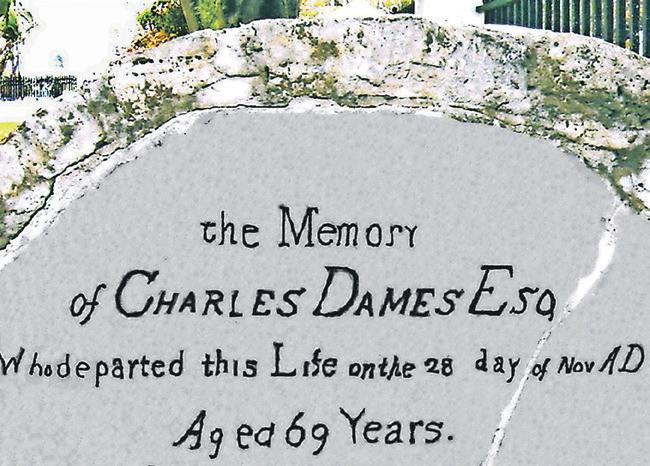
we learned how to clean gravestones without damaging them.
We seldom saw anyone in the cemeteries, but while we were cover ing the area between St Matthew’s Church and Shirley Street, a man, with a folded white garment under his arm, stopped to chat with us. We assumed he had just come from serv ing at the altar.
We paid no attention to his leav ing, but a little later, when we went to re-photograph the grave of E S Fisher (hidden under a huge tree, never seeing sunlight), on top of the fenced-in grave, in the quiet south west corner, our ‘friend’, covered by his white garment, was sound asleep.
Something I had never seen before was a memorial to someone who was still alive. We discovered two such headstones.
The Shirley Street gate to the Jewish Cemetery, the tidiest and
best maintained of the four, was always locked. Some of the earlier graves were in the Myers plot and the Myers family had established an endowment to keep the entire cemetery clean. Fortunately, we were fit enough to climb over its wall.
Originally, the Center Burial Ground (the oldest on New Provi dence) was much bigger than the walled-in area that one sees today and there was no wall. A lot of old graves were sacrificed to re-routings of Dowdeswell Street, but there is history in the tombstones –Thomas Pinckney, died 1733, is the oldest that I have found. Deborah Gambier, wife of the Lieutenant Governor and mother of Baron John Gambier - Cantwell Scull, who had owned Lot #29 (on the corner of Bay and Frederick Streets) in the town of Nassau; d. 1758 - John Wells, founder and publisher of the Bahamas Gazette, the first news paper in the Bahamas. He (and his newspaper) died in 1799.
Once these four cemeteries had been covered, I moved on to the Western and St Mary’s Cemeter ies, between Nassau and Augusta Streets, but they will have to wait for another article.

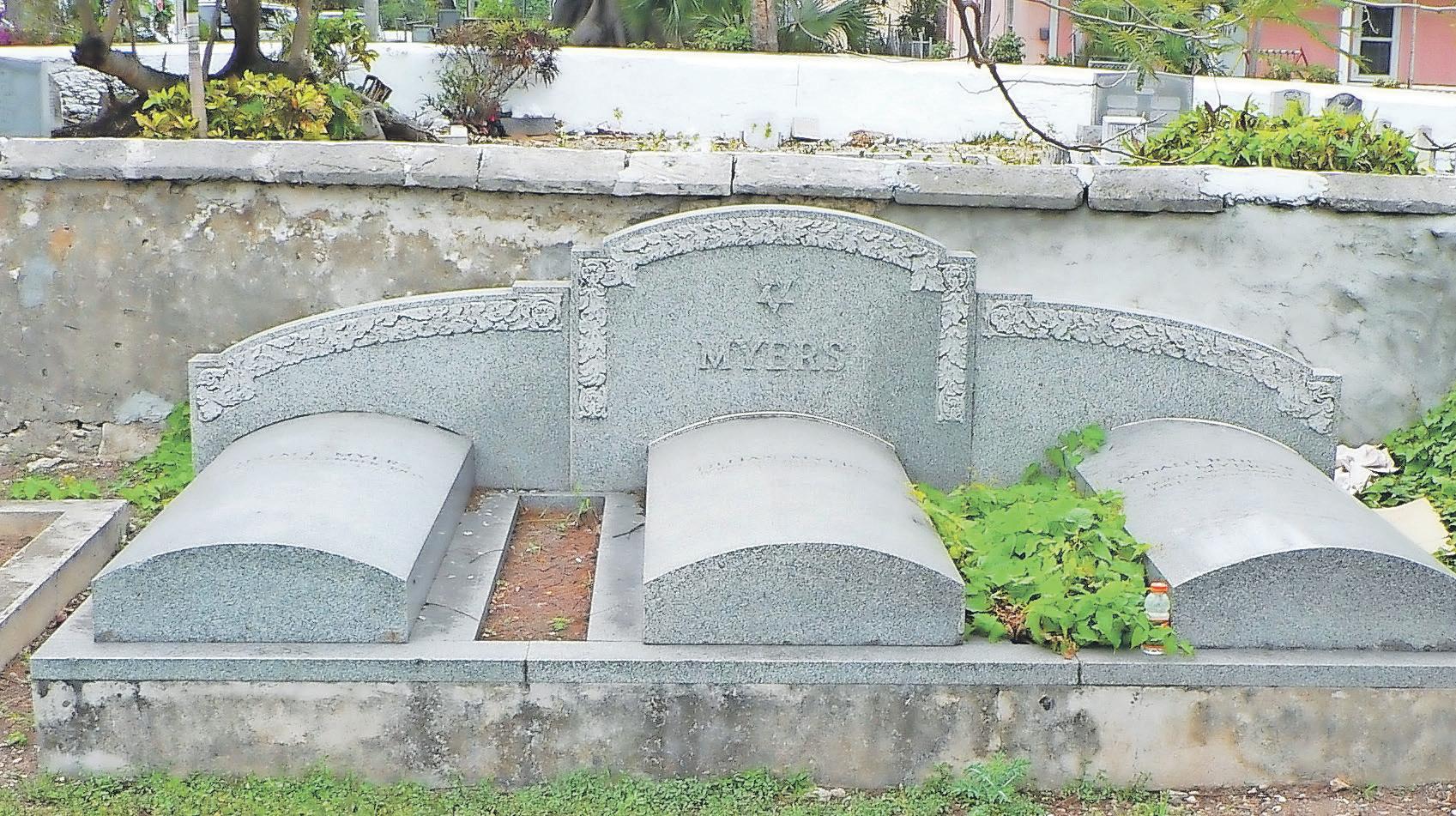
LOSS of our faithful friends can be really devastating for the humans left behind.
I get a little fed up with people who act puzzled when we feel such intense pain and loss; these are usually the charmers who preface their comments with the word “only”. Only a dog, horse, cat, bird…
When you stop and think about it, most of our family live elsewhere, even if it is on the island of New Providence. We do not necessarily see each other all day every day; we do not take our relatives to work as some pet owners do with their furry loved ones. Our family and friends do not sleep on our beds, or in our bedrooms; they are not there underfoot and beside us all day long.
So, when we lose a pet, a beloved member of our immediate family it is a huge hole in our hearts and in our daily lives. Nothing feels quite the same again.
Recently, Gabby, a beautiful golden passed away. She was an amazing 16 years old. Gabby had been rescued from a situation where her owner could no longer care for her and had no family members available to do so. She was surrendered to Sandra Cooke of Pet Heaven in Marsh Harbour with two younger goldens; Gabby was already nine years old and it is not always easy to find a home for a pet of that age, but Gabby landed on all four paws and found just the best home ever.
Gabby moved from Abaco to New Providence and took up residence with her new family, the vice president of the Bahamas Humane Society, Charlotte Albury, and John Darville. She immediately fit in and brought her gentle dignity and unobtrusive lifestyle with her.
Gabby did not give away kisses, nor did she demand attention; she was not the typical run of the mill golden. She was totally content to just be there and be with the humans she loved. She loved going to the office

with her master and would peacefully lie in his office, enjoying his presence and the sounds of the office around her. She enjoyed the car ride to and from her “job”, and everybody in the office is feeling her absence markedly. This lovely, quiet, undemanding but ever-present girl, is simply not there anymore. That magnificent large tail that could thump the floor with approval when appropriate, is not there anymore. She touched the lives of all the office workforce as she was a constant fixture, and they miss her. When a family pet leaves our lives the gaping void remains for a very long time, the memory lasts forever.
Goldens are usually very “soppy” dogs, big goofy clowns, demanding love from everybody they meet and wanting to befriend all the dogs they come across, but Gabby was very atypical. She really didn’t like other dogs very much, she kept her dis tance, and felt no need to play with them or snuggle up to them; she was a very poised individual. Not much is known about her life before she moved into her Nassau home for the past seven years. Maybe her life prior to coming to Nassau molded her to be an independent soul, we will never know. One thing we do know is that she lived the most marvelous life with Charlotte and John; she was spoiled rotten, loved and indulged. She was cared for and treated with the upmost kindness.
She loved flying to Abaco for long weekends at Treasure Cay and her runs on the beach, which became shorter and less active as the years piled up. She was a seasoned travel ler who settled down in her charter
flight, allowing her humans to join her, snoozing during the short flight. Gabby didn’t have a care in the world, and that is exactly how it should be. Our pets mould us, and teach us that unconditional love does exist, and fortunately exists in both directions. They love us without judgement, but in a real bond between human and pet, we also accept them uncondi tionally and accept that as they get older, they will need more care, more patience and more understanding. We, the privileged humans, caring for them, provide that nonjudg mental care and understanding and actually learn so much more about
the boundaries of love that are, in essence, endless. Animals teach us some of the most essential life lessons, and people who do not have animal teachers in their lives miss out hugely.
Though Gabby’s family mourn her, and miss her terribly, they have the reassurance that she lived the most amazing years with them, she knew she was loved, she knew that she was safe and had nothing to ever fear, her food and water bowl full and kindness was the only language spoken, there is no greater gift you can give your pet. RIP pretty girl; I hope you find Chiefie up there.

Lincoln is pretty new to the Bahamas Humane Soci ety but already knows how to turn on the charm with those pleading ‘Adopt Me’ eyes.
Lincoln is about four months old and still very much a puppy, so would like to go to a home that understands he’ll need room to sniff and grow and some things to chew on while he’s teething. He gets along well with the other pups and would prob ably be trainable around cats as he’s young and smart
and eager to learn. Do you have just the right home for Lincoln? If so, come to the BHS or call 325-6742 for more information. Lincoln looks forward to chewing on... erm, meeting you!
• The BHS Thrift Shop is open and ready to sell you all kinds of wonderful things! Books, clothing, house wares, giftware, art, and much more. Wednesday/ Thursday/Friday from 11am to 3pm, and Saturday from 10am to 2pm. Bring your bag!
THE Young Reporters for the Environment students (YRE) in the Bahamas and the Bahamas Reef Environment Educational Founda tion (BREEF) gained international recognition for their initiative on climate action and approach to com bating plastic pollution.


Recently featured in a UNDP article called, “Turning the tide –How local NGOs in Seychelles and the Bahamas are working to raise awareness and inspire action to address marine plastic pollution,” YRE students share the importance of giving our marine environment a voice.
The YRE programme aims to empower students aged 11-25 to take a stand on environmental issues they feel strongly about and give them a platform to call attention to these issues through the media of writing, photography, or video. There are more than 350,000 young reporters in 45 countries across the world.
BREEF started implementing the YRE pro gramme in 2019, making The Bahamas the first country in the Caribbean to offer the programme. Since then, students from all over the archipelago have participated in journalism and photogra phy workshops, and snorkel field trips led by BREEF to the mangrove and coral reefs. They have also partici pated annually in the “Young Reporters for the Environ ment National Competition” submitting entries on local and global environmental issues.
“What motivates my friends and me to pro tect nature is sustaining it for future generations. Nature is often neglected by human beings in today’s world and now its survival is becoming such a vital aspect of life. We have to protect it,” said Kaitlyn Archer.
BREEF’s underwater classroom at the Sir Nicholas Nuttall Coral Reef Sculpture Garden & Coral Nursery.

YOUNG Reporter for the Environment student, Kait lyn Archer, makes a presentation to snorkellers.
and climate change.
Kaitlyn and her peers are par ticipating in a youth-focused project with BREEF aimed at increasing knowledge about marine ecosystems and the threats they face, including plastic pollution, biodiversity loss
The project was initially funded by the Global Environment Facility Small Grants Programme (SGP). Lombard Odier & Cie (Bahamas) Ltd is a key sponsor of the rapidlygrowing programme.
“YRE is an amazing programme because it allows young people to utilize social media in an impactful way, expressing their concerns about the environment and proposing
solutions. YRE teaches our youth how to com municate effec tively by utilising a cuttingedge approach to disseminate news,” said Allison Longley, national opera tor for YRE in the Bahamas.
YRE students participating in a PADI Women’s Day snorkel event.